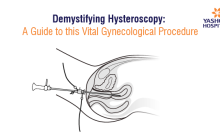Advancements in Gynecology: Exploring the Realm of Robotic Surgery


In recent years, the field of gynecology has witnessed a remarkable transformation with the introduction of robotic surgery. This groundbreaking technology has revolutionized the way complex gynecological procedures are performed, offering patients and surgeons alike a myriad of benefits. From enhanced precision to quicker recovery times, robotic surgery has paved the way for safer and more effective treatments for a variety of gynecological conditions.
The Evolution of Robotic Surgery in Gynecology:
Robotic surgery, also known as robot-assisted surgery, utilizes advanced robotic systems to assist surgeons in performing intricate procedures with unparalleled precision. While the concept of robotic surgery originated in the 1980s, it wasn’t until the early 2000s that it began to gain traction in the field of gynecology. Since then, robotic-assisted techniques have become increasingly prevalent in the treatment of various gynecological conditions, including endometriosis, uterine fibroids, ovarian cysts, and gynecologic cancers.


Applications of Robotic Surgery:
One of the primary advantages of robotic surgery in gynecology is its versatility. Robotic systems, such as the da Vinci Surgical System, allow surgeons to perform a wide range of procedures with greater precision and control. Some common types of robotic surgery in gynecology include:
- Hysterectomy: Robotic-assisted hysterectomy, the surgical removal of the uterus, is one of the most common gynecological procedures performed using robotic technology. This minimally invasive approach offers patients smaller incisions, reduced blood loss, and faster recovery times compared to traditional open surgery.
- Myomectomy: For women with symptomatic uterine fibroids, robotic myomectomy provides a less invasive alternative to traditional open surgery. By utilizing robotic arms controlled by the surgeon, fibroids can be removed with greater precision while preserving the integrity of the uterus.
- Endometriosis Resection: Endometriosis, a painful condition characterized by the growth of uterine tissue outside the uterus, can be challenging to treat surgically. Robotic surgery for endometriosis enables surgeons to precisely excise endometrial implants while minimizing damage to surrounding tissues, leading to improved outcomes and symptom relief for patients.
- Robotic Oophorectomy: Robotic oophorectomy involves the surgical removal of one or both ovaries using robotic-assisted techniques. This approach offers advantages such as smaller incisions, reduced postoperative pain, and faster recovery times compared to traditional open surgery.
- Robotic Sacrocolpopexy: Robotic sacrocolpopexy is a minimally invasive procedure used to treat pelvic organ prolapse by reinforcing the pelvic floor with mesh. Robotic-assisted techniques allow for precise placement of the mesh and sutures, resulting in durable support and improved outcomes for patients.
- Ovarian Cystectomy: Robotic surgery can be used to remove ovarian cysts while preserving the ovaries. This approach is less invasive than traditional open surgery and can lead to faster recovery and reduced scarring.
Advantages of Robotic Surgery:
The adoption of robotic surgery in gynecology has brought about numerous benefits for both patients and surgeons:
- Enhanced Precision: Robotic systems offer superior dexterity and range of motion, allowing surgeons to perform intricate maneuvers with greater accuracy than conventional laparoscopic techniques
- Reduced Trauma: Minimally invasive robotic procedures result in smaller incisions, less tissue damage, and reduced blood loss compared to open surgery, leading to faster recovery times and decreased postoperative pain for patients.
- Improved Visualization: Robotic-assisted surgery provides high-definition, three-dimensional imaging, giving surgeons a clear view of the surgical site and enabling precise dissection and suturing.
- Shorter Hospital Stays: Patients undergoing robotic surgery typically experience shorter hospital stays and a faster return to normal activities compared to those undergoing traditional open surgery.
- High Success Rates: Gynecology has demonstrated excellent success rates in robotic surgery across various procedures, with outcomes comparable to or even superior to those of conventional approaches. Studies have shown that robotic-assisted techniques offer favorable surgical outcomes, including lower complication rates and improved patient satisfaction.
Robotic Surgery Procedures and Recovery
Robotic surgery procedures involve the following steps:
- Patient Preparation: Patients undergo preoperative evaluation and preparation, including medical history review, physical examination, and imaging studies.
- Anesthesia: General anesthesia is administered to ensure patient comfort and safety throughout the procedure.
- Incision and Port Placement: Small incisions are made in the abdomen to insert robotic arms and surgical instruments. Ports are placed strategically to provide access to the surgical site.
- Robotic Instrumentation: Surgeons control robotic arms from a console, manipulating instruments with precision and performing the necessary surgical maneuvers.
- Closure: Incisions are closed with sutures or surgical tape, and dressings are applied to promote healing and prevent infection.
Robotic surgery recovery times vary depending on the specific procedure and individual patient factors. However, patients generally experience shorter recovery times and less postoperative pain compared to traditional open surgery.
Explore Precision Surgery Options and Discover Top Gynecology Robotic Surgeons Here!
Future Directions:
As technology continues to advance, the future of robotic surgery in gynecology looks promising. Ongoing research and development efforts aim to further enhance robotic systems, improving their capabilities and expanding their applications in the field of gynecological healthcare. From the development of new robotic instruments to the integration of artificial intelligence and augmented reality, the possibilities for innovation are endless.
Robotic surgery has emerged as a game-changer in the field of gynecology, offering patients minimally invasive treatment options with improved outcomes and faster recovery times. As technology continues to evolve, robotic-assisted techniques will likely become even more prevalent, shaping the future of gynecological healthcare and paving the way for safer, more effective treatments for women around the world.
Frequently Asked Questions:
- What are the advantages of robotic surgery?
Advantages include precision, smaller incisions, reduced blood loss, quicker recovery times, increased surgeon range of motion, and reduced risk of infection due to minimize tissue trauma.
- How has robotic surgery improved surgery?
Robotic surgery has enhanced surgical capabilities by enabling intricate maneuvers with tiny instruments, providing magnified, high-definition 3D visualization, and facilitating minimally invasive techniques for faster healing.
- What is robotic surgery used for?
Robotic surgery is employed across various disciplines for procedures such as prostatectomy, hysterectomy, myomectomy, colorectal surgery, thoracic surgery, and even intricate cardiac interventions.
- Does robotic surgery improve outcomes?
Yes, robotic surgery often leads to superior outcomes by reducing complications, accelerating patient recovery, minimizing post-operative pain, and offering improved cosmetic results.
- How safe is robotic surgery?
While generally safe, robotic surgery requires skilled operators and proper equipment maintenance to mitigate risks associated with technical failures, such as instrument malfunction or unintended tissue injury.
- What is the future of robotic surgery?
The future involves advancements like autonomous robotic systems, integration with artificial intelligence for real-time decision-making, and further miniaturization to enable procedures at the cellular level.
- What is the role of robotic surgery in gynecology surgery?
Robotic surgery in gynecology provides unparalleled precision for delicate procedures like hysterectomy, myomectomy, endometriosis excision, and sacrocolpopexy, resulting in reduced blood loss, shorter hospital stays, and faster recovery, particularly beneficial for reproductive health and pelvic floor disorders.
- What is the best robotic surgery hospital in India?
Yashoda Hospitals is renowned for its excellence in robotic surgery, offering state-of-the-art facilities, experienced surgeons, and a wide range of robotic procedures across multiple specialties.
About Author –
About Author
Recent Posts
రక్తదానం: అర్హులు, ప్రయోజనాలు మరియు అపోహల గురించి సంక్షిప్త సమాచారం
మనిషి బ్రతకడానికి ప్రాణవాయువు ఆక్సిజన్ ఎంత అవసరమో రక్తం కూడా అంతే అవసరం. రక్తం, శరీరంలోని ప్రతి కణంతో అనుక్షణం…
నరాల సంబంధిత వ్యాధుల రకాలు, కారణాలు, లక్షణాలు & నిర్ధారణ పరీక్షలు
నరాల సంబంధిత రుగ్మతలు అంటే నాడీ వ్యవస్థ మొత్తం మీద ప్రభావం చూపే వ్యాధులు. నాడీ సంబంధిత పరిస్థితులు ఇప్పుడు…
Endovascular Surgery: Minimally Invasive Solution to Vascular Disease
Endovascular surgery is a revolutionary advancement in medical technology wherein doctors can treat almost any…
పల్మోనరీ ఎంబోలిజం: లక్షణాలు, కారణాలు మరియు చికిత్స విధానాలు
పల్మోనరీ ఎంబోలిజం అనేది చికిత్స మీద ఆధారపడిన ఒక తీవ్రమైన పరిస్థితి, ఇది సాధారణంగా ఊపిరితిత్తులకు ప్రయాణించే రక్తంలో గడ్డకట్టడం…
Rhinoplasty: Understanding the Nose Surgery Procedure and Its Benefits
Rhinoplasty is commonly known as a nose job that is usually designed to reshape a…
Is Spine Surgery Safe? Exploring Minimally Invasive Techniques and Recovery
Spine surgery is a source of fear for most people, yet it has undergone significant…


